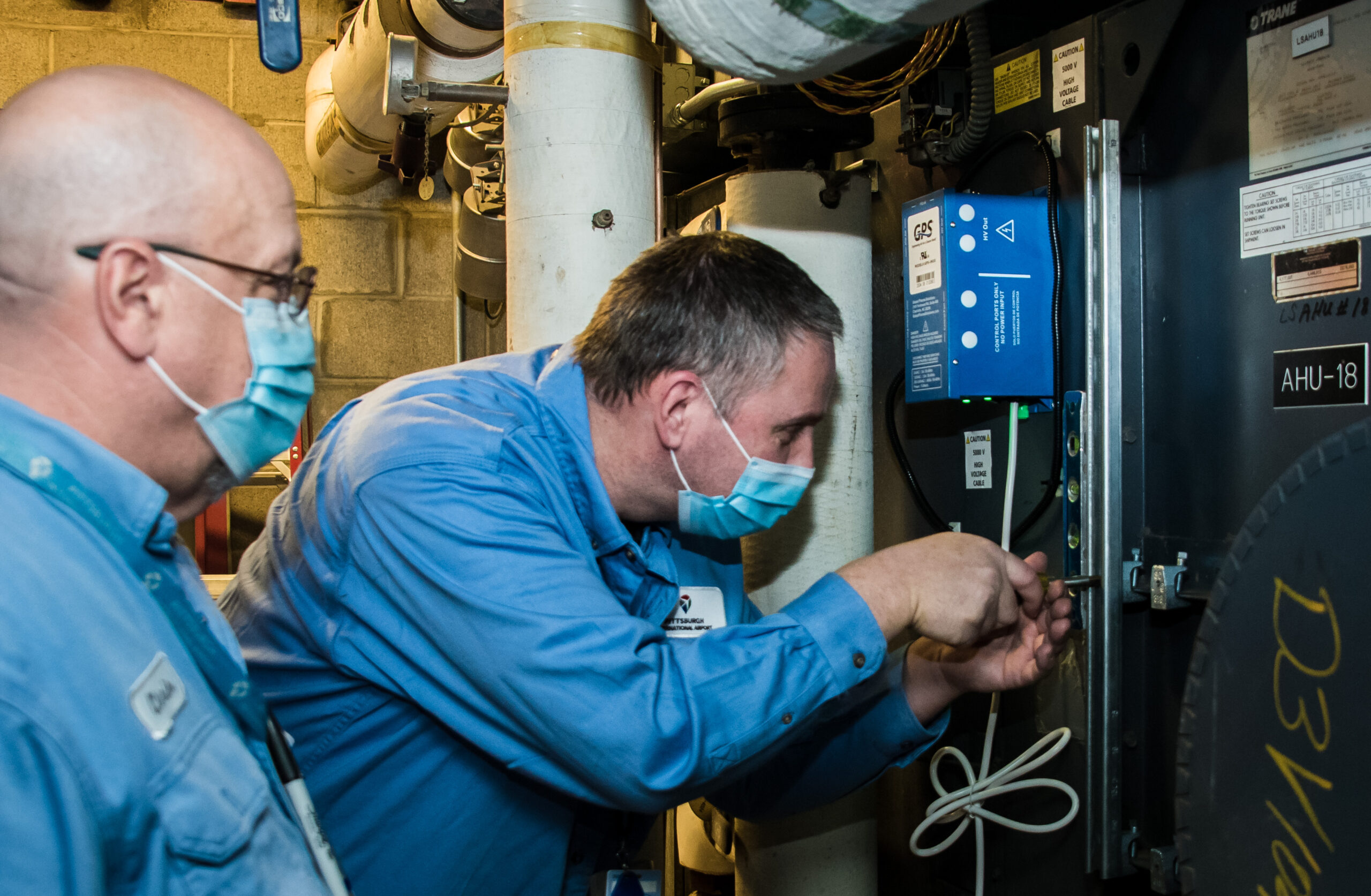PIT Turns to Ionization to Purify Airport Air
State-of-the-art technology upgrades HVAC filtration, aims to reduce virus spread
By Matt Neistei
Published March 1, 2021
Read Time: 3 mins
No matter what you’re doing at Pittsburgh International Airport—traveling, visiting, working—or where you go while you’re there, you share one thing in common with the millions of others who pass through each year: the air.
And with the airborne threat of COVID-19 recalibrating everyone’s idea of health and safety, PIT’s operations and safety teams have zeroed in on the atmosphere in the airport as a focal point in keeping passengers and workers as safe as possible.
Last week, airport engineers and electricians began installing a state-of-the-art ionization system in the facility’s HVAC infrastructure as part of a pilot project launched with the help of Allegheny Health Network and Honeywell.
“I’ve always felt our team did an excellent job maintaining our HVAC system. The pandemic obviously brought a heightened focus on indoor air quality,” said Rusty Hottenfeller, Director of Facilities and Airline Services for PIT. “We evaluated filter changes and preventive maintenance with our air handler units and then looked for ways to get better.”
The airport assembled a multi-departmental Indoor Air Quality team to review available technologies and possible vendors. The group settled on the addition of “needlepoint bi-polar ionization” from Global Plasma Solutions for two units in the Landside Terminal, Hottenfeller said.
In a nutshell, the GPS-iMOD device creates and releases ions—negatively charged molecules and atoms—into the HVAC system. When the ions disperse, they form bonds with other particles in the air. The particles continue to cluster, and the larger they become, the easier it is for the HVAC system to safely filter them out of the air.
GPS says the process is certified as ozone-free by safety certification company UL and cites independent laboratory tests that prove the device is successful at limiting the spread of viruses, including a 90 percent deactivation rate for coronavirus.
“Adding the latest technologies to our facility is always at the forefront for the maintenance team, and this project will definitely contribute to ensuring a safe passenger journey and a safe place for our employees to work,” Hottenfeller said.
Utilizing ionization as part of air purification dates back to the 1960s, although the problem of ozone generation during the process has been a hindrance to widespread adoption of the technology.
As the team examined solutions for improving the atmosphere at PIT, they reached out to Allegheny Health Network, an integrated healthcare delivery system in the Western Pennsylvania region composed of 13 hospitals and more than 2,500 physicians, to learn more about medical-grade air quality and best practices.
“Allegheny Health Network is proud to work with Pittsburgh International Airport on this innovative and proactive initiative,” said Susan Manzi, MD, MPH, Chair of the Medicine Institute at Allegheny Health Network. “As clinicians who have been on the front lines of the COVID-19 pandemic since day one, we understand the necessity of proper facility sanitation to prevent further spread of the virus.
“We applaud the airport’s efforts to achieve hospital-grade sanitation and safety for its travelers and are grateful to be a trusted advisor in the process. We are truly all in this together and doing everything possible to end the spread of COVID-19.”
The addition of ionization to the airport’s filtration processes comes shortly after the announcement of a partnership with Honeywell to develop a live dashboard measuring air quality that will help staff identify and correct issues in real time.
From launching a dedicated Safe Travels initiative to deploying the first UV-equipped autonomous floor scrubbers in a U.S. airport, PIT continues to focus on improving the safety of its facilities, and the ionization devices are just the latest effort, Hottenfeller said.
“Collaborating with Honeywell by building out our dashboard as we are capturing the metrics and data from our systems will ensure we get the absolute best return on this project,” he said.
Watch
This Next
Read
This Next






